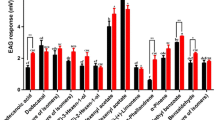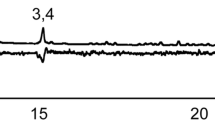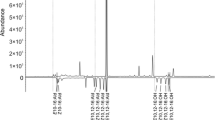Abstract
Anoplophora malasiaca (Thomson) (Coleoptera: Cerambycidae) is a serious pest that affects various crop trees and landscapes in Japan. We collected and analyzed volatiles from male and female A. malasiaca. 4-(n-Heptyloxy)butan-1-ol and its aldehyde, pheromone components in A. glabripennis and A. chinensis, were detected in the male volatile extracts and nonanal both in the male and female volatile extracts. Nonanal was absent from the extracts of twigs of the willow host plant. Gas chromatograph-electroantennographic responses showed that nonanal and 4-(n-heptyloxy)butan-1-ol elicited responses from both male and female antennae, but 4-(n-heptyloxy)butanal did not. Volatiles of eight artificially reared males, analyzed every 3 or 4 days for 60 days from adult emergence showed that they all produced nonanal and 4-(n-heptyloxy)butan-1-ol. The two compounds produced no short-range female attraction but in males, the short-range attraction to nonanal was dose dependent and significant in a higher dose, but did not depend on 4-(n-heptyloxy)butan-1-ol. When wounded willow twigs were added to nonanal and 4-(n-heptyloxy)butan-1-ol, the frequency of male responses was higher than in all other treatments, but the same as wounded willow twigs alone. The wounded host plant willow twigs might thus be enough for male attraction. The identified volatiles from the beetles in the present study might have a weaker function for attraction from the distance compared to their host plant volatiles.





Similar content being viewed by others
References
Crook DJ, Lance DR, Mastro VC (2014) Identification of potential third component of the male-produced pheromone of Anoplophora glabripennis and its effect on behavior. J Chem Ecol 40:1241–1250
Fujiwara-Tsujii N, Yasui H, Wakamura S, Hashimoto I, Minamishima M (2012) White-spotted longicorn beetle, Anoplophora malasiaca (Thomson) (Coleoptera: Cerambycidae), with a blueberry host may utilize original host chemicals for mate location. Appl Entomol Zool 47:103–110
Fujiwara-Tsujii N, Yasui H, Tanaka S (2016) A comparison of fecundity and longevity of Anoplophora malasiaca (Coleoptera: Cerambycidae) adults fed on three different host plants. Entomol Sci 19:201–206
Fukaya M, Akino T, Yasuda T, Wakamura S, Satoda S, Senda S (2000) Hydrocarbon components in contact sex pheromone of the white-spotted longicorn beetle, Anoplophora malasiaca (Thomson) (Coleoptera: Cerambycidae) and pheromonal activity of synthetic hydrocarbons. Entomol Sci 3:211–218
Fukaya M, Akino T, Yasuda T, Yasui H, Wakamura S (2004) Visual and olfactory cues for mate orientation behaviour in male white-spotted longicorn beetle, Anoplophora malasiaca. Entomol Exp Appl 111:111–115
Fukaya M, Yasui H, Yasuda T, Akino T, Wakamura S (2005) Female orientation to the male in the white-spotted longicorn beetle, Anoplophora malasiaca by visual and olfactory cues. Appl Entomol Zool 40:63–688
Haack R, Herard F, Sun J, Turgeon J (2010) Managing invasive populations of Asian longhorned beetle and citrus longhorned beetle: a worldwide perspective. Annu Rev Entomol 55:521–546
Hansen L, Xu T, Wickham J, Chen Y, Hao D, Hanks LM, Millar JG, Teale SA (2015) Identification of a male-produced pheromone component of the citrus longhorned beetle Anoplophora chinensis. PLoS ONE 10(8):e0134358
Hérard F, Ciampitti M, Maspero M, Krehan H, Benker U, Boegel C, Schrage R, Bouhot-Delduc L, Bialooki P (2006) Anoplophora spp. in Europe: infestations and management process. Bull OEPP 36:470–474
Kojima K, Nakamura S (1986) Food Plants of Cerambycid Beetles (Cerambydae, Coleoptera) in Japan. Hiba Society of Natural History Press, Hiroshima, pp 128–133 (in Japanese)
Muraji M, Wakamura S, Yasui H, Arakaki N, Sadoyama Y, Ohno S, Matsuhira K (2011) Genetic variation of the white-spotted longicorn beetle Anoplophora spp. (Coleoptera: Cerambycidae) in Japan detected by mitochondrial DNA sequence. Appl Entomol Zool 46:363–373
Nehme ME, Keena MA, Zang A, Baker TC, Hoover K (2009) Attraction of Anoplophora glabripennis to male-produced pheromone and plant volatiles. Environ Entomol 38:1745–1755
Ohbayashi N (1992) Genus Anoplophora Hope, 1839. In: Satô M, Kojima K (eds) An Illustrated Guide to Identification of Longicorn Beetles of Japan. Tokai University Press, Tokyo, pp 583–584 (in Japanese)
Sjöman H, Östberg J, Nilsson J (2014) Review of host trees for wood-boring pests Anoplophora glabripennis and Anoplophora chinensis: An urban forest perspective. Arboric Urban For 40:143–164
Sokal RR, Rohlf FJ (1995) Biometry, the principles and practice of statistics in biological research, 3rd edn. W. H. Freeman and Company, New York, p 887
Struble DL, Arn H (1984) Combined gas chromatography and electroantennogram recording of insect olfactory responses. In: Hummel HE, Miller TA (eds) Techniques in Pheromone Research. Springer-Verlag, New York, pp 161–178
Wickham JD, Xu Z, Teale SA (2012) Evidence for a female-produced, long range pheromone of Anoplophora glabripennis (Coleoptera: Cerambycidae). Insect Sci 19:355–371
Yasui H (2009) Chemical communication in mate location and recognition in the white-spotted longicorn beetle, Anoplophora malasiaca (Coleoptera: Cerambycidae). Appl Entomol Zool 44:183–194
Yasui H, Akino T, Yasuda T, Fukaya M, Ono H, Wakamura S (2003) Ketone components in contact sex pheromone of the white-spotted longicorn beetle, Anoplophora malasiaca, and pheromonal activity of synthetic ketones. Entomol Exp Appl 107:167–176
Yasui H, Akino T, Yasuda T, Fukaya M, Wakamura S, Ono H (2007a) Gomadalactones A, B, and C: novel 3-oxabicyclo[3.3.0]octane compounds in the contact sex pheromone of the white-spotted longicorn beetle Anoplophora malasiaca. Tetrahedron Lett 48:2395–2400
Yasui H, Yasuda T, Fukaya M, Akino T, Wakamura S, Hirai Y, Kawasaki K, Ono H, Narahara M, Kousa K, Fukuda T (2007b) Host plant chemicals serve intraspecific communication in the white-spotted longicorn beetle, Anoplophora malasiaca (Thomson) (Coleoptera: Cerambycidae). Appl Entomol Zool 42:255–268
Yasui H, Akino T, Fukaya M, Wakamura S, Ono H (2008) Sesquiterpene hydrocarbons: kairomones with a releaser effect in the sexual communication of the white-spotted longicorn beetle, Anoplophora malasiaca (Thomson) (Coleoptera: Cerambycidae). Chemoecology 18:233–242
Yasui H, Fujiwara-Tsujii N, Wakamura S (2011) Volatile attractant phytochemicals for a population of white-spotted longicorn beetles Anoplophora malasiaca (Thomson) (Coleoptera: Cerambycidae) fed on willow differ from attractants for a population fed on citrus. Chemoecology 21:51–58
Zhang A, Oliver JE, Aldrich JR, Wang B, Mastro VC (2002) Stimulatory beetle volatiles for the Asian longhorned beetle, Anoplophora glabripennis (Motschulsky). Z Naturforsch C 57:553–558
Acknowledgements
We thank Prof. Jocelyn G Millar of University of California Riverside for kindly providing synthetic 4-(n-heptyloxy)butan-1-ol and offering valuable advice on our experiments. We thank Yuta Goto and Akira Tamanoi of Oita Prefectural Fruit Tree Research Institute for providing the citrus twigs, Takashi Noda of Japan Plant Protection Association for collecting the insects. We also thank Ikuko Hashimoto, Masako Higuchi, and Yukiko Tsushima of NARO for assistance with the behavioral assays and insect rearing. This project was partially supported by a Grant-in-Aid for Scientific Research (C) (17K07686) and a Grant-in-Aid for Challenging Exploratory Research (16K14867) from the Ministry of Education, Culture, Sports, Science and Technology, Japan. We thank Elizabeth Kelly, MSc, Mallory Eckstut, PhD, and Philip Creed, PhD from Edanz Group (www.edanzediting.com/ac) for editing drafts of this manuscript.
Author information
Authors and Affiliations
Corresponding author
Additional information
Publisher's Note
Springer Nature remains neutral with regard to jurisdictional claims in published maps and institutional affiliations.
Rights and permissions
About this article
Cite this article
Yasui, H., Fujiwara-Tsujii, N. & Yasuda, T. Detection of volatile pheromone candidates from the white-spotted longicorn beetle, Anoplophora malasiaca (Coleoptera: Cerambycidae). Appl Entomol Zool 54, 203–211 (2019). https://doi.org/10.1007/s13355-019-00614-4
Received:
Accepted:
Published:
Issue Date:
DOI: https://doi.org/10.1007/s13355-019-00614-4




